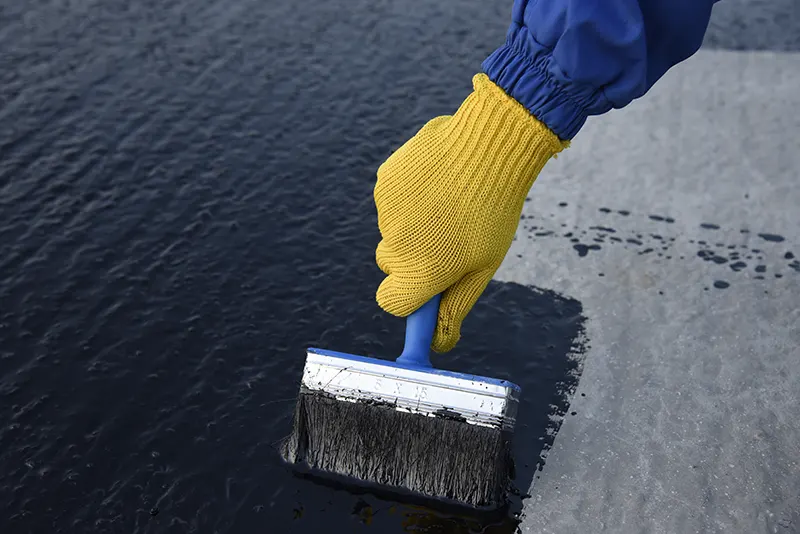

If you’re from Long Island, Brooklyn, Queens or the Bronx you can attest to the fact that thee areas suck when it comes to water. It means dealing with the occasional heavy rain, humid summers, and winter snow. For homeowners in these boroughs, keeping a dry basement is a must and a difficult feat. That’s where waterproofing inside your basement comes into play.
In this blog, we’ll cover what waterproofing inside a basement involves, why it matters, and how you can protect your home with the right strategies. We’ll also talk about waterproof basement techniques, who to ask for help and the benefits of using a basement waterproofing membrane. Let’s dive in!
What is Interior Basement Waterproofing?
Interior basement waterproofing means exactly what it sounds, taking steps from the inside of your home to keep water out. It differs from exterior waterproofing, which works from the outside.
Interior waterproofing is often easier on the pocket and less invasive. It involves managing water that gets into the basement and redirecting it safely away.
This method is perfect for older homes in Long Island or Brooklyn where exterior access may be difficult.
Why Waterproofing Your Basement Matters
Imagine inviting your friends over to a wet basement that gives off this weird stench – a sure way to kill the vibe. But a wet basement is more than just a nuisance. It can cause real problems:
- Mold and mildew growth
- Musty odors
- Damage to walls, floors, and stored belongings
- Decreased home value
Waterproofing your basement helps prevent these issues. For homes in Queens and the Bronx, where water tables can be high and old infrastructure common, waterproofing is a smart investment.
Signs You Need Basement Waterproofing
Here are a few signs that your basement needs waterproofing:
- Damp walls
- White powder (efflorescence) on masonry
- Musty smell
- Water stains or puddles after rain
- Cracks in walls or floors
If you spot any of these signs, it’s time to consider waterproofing inside your basement.
How Interior Waterproofing Works
Interior waterproofing typically involves these steps:
- Sealing Cracks: All wall and floor cracks are sealed to stop water seepage.
- Installing a Drainage System: A trench is dug along the basement perimeter, and a drain pipe is laid.
- Sump Pump Installation: Water from the drainage system is directed to a sump pump, which pushes it outside.
- Applying a Basement Waterproofing Membrane: A waterproof membrane is applied to walls to prevent water from coming through.
This system keeps basements in Long Island and Queens dry even during heavy rain.
The Role of a Basement Waterproofing Membrane
A basement waterproofing membrane is like a shield for your walls. It prevents water from seeping through the surface.
These membranes can be:
- Liquid-applied: Painted on and dries to form a rubbery barrier.
- Sheet membranes: Rolled on the walls for extra strength.
They are great for homes in the Bronx and Brooklyn where old concrete can easily crack.
Benefits of Waterproofing Inside Basement Walls
Here’s what you gain from waterproofing your basement:
- Dry, usable space
- Protection for valuables stored in the basement
- Healthier indoor air
- Higher property value
- Peace of mind during storms
Long Island homeowners especially value the extra usable space they gain.
DIY vs. Professional Waterproofing
Some homeowners try DIY methods. You can seal small cracks and apply simple waterproofing paints.
But for full systems with sump pumps and drainage, it’s best to call the pros.
Waterproofing Experts NY knows the soil, weather, and construction styles in Queens, the Bronx, Brooklyn, and Long Island. That local knowledge helps us choose the best solutions for your home.
Cost of Interior Basement Waterproofing
Costs vary depending on:
- Size of the basement
- Amount of water intrusion
- Type of membrane used
- Sump pump or drainage system required
On average, homeowners in the New York metro area spend between $3,000 to $8,000. The investment is worth it to avoid future repairs and keep your basement dry year-round.
Choosing the Right Waterproofing Contractor
Not all contractors are the same. When choosing someone to waterproof your basement, look for:
- Local experience in Long Island, Brooklyn, Queens, or the Bronx
- Licensed and insured
- Transparent pricing
- Positive customer reviews
Waterproofing Experts NY meets all these criteria. Our team is dedicated to protecting homes in our local community.
Maintenance Tips After Waterproofing
To keep your basement dry after waterproofing:
- Test your sump pump regularly
- Check for new cracks
- Keep gutters clean and pointed away from your home
- Use a dehumidifier in summer months
These simple tips go a long way in maintaining a waterproof basement.
Final Thoughts
Waterproofing inside your basement isn’t just about avoiding puddles or maintaining a vibe. It’s about protecting your home, health, and peace of mind.
If you live in Long Island, Brooklyn, Queens, or the Bronx, and see signs of moisture in your basement, don’t wait.
Let Waterproofing Experts NY help you create a dry, safe, and comfortable space.
Call us today to schedule your free inspection!Or visit our website for more information today!